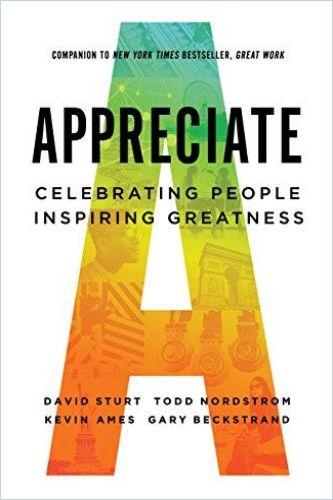Executives from the insight firm O.C. Tanner offer a solid guide for showing appreciation to your employees and colleagues.

Show Appreciation
Executives from O.C. Tanner – a research and insights firm – came together with an all-star team of authors, speakers and consultants to demonstrate how appreciation can be a positive force in the workplace. David Sturt wrote the bestseller Great Work. Todd Nordstrom hosts the Great Work Insights podcast. Kevin Ames is a frequent presenter and public speaker, and Gary Beckstrand consults with Fortune 100 companies.
Everyone enjoys appreciation, yet, the authors maintain, many businesses fail to create cultures that prioritize this complex emotion. In this practical text, employee recognition experts Sturt, Nordstrom, Ames and Beckstrand teach business leaders how to recognize their team members’ efforts. Such recognition inspires loyalty and helps motivate employees to perform innovative, boundary-pushing work. The authors write in a clear, applicable style, and offer persuasive arguments for the value-building benefits of adopting a spirit of appreciation as part of your corporate culture.
You might think that the positive force of appreciation would be obvious to everyone, even executives. But the warm welcome this guide received suggests the authors are correct when they claim that most leaders ignore this crucial aspect of leadership. For example, Prabir Jha, former president of Cipla, said, “Great book! Simple philosophy. Brilliant practice. We often get stuck focusing on the policies, procedures and business systems of work, but forget the fact that we’re all just people trying to do great work.” Jay Samit, best-selling author of Disrupt You!, said, “In a concise and definitive manner, Appreciate shows the power and impact this simple act can give to creating world-class influencers who can lead any industry.”
Brain Chemistry
The authors explain that when you experience appreciation, your brain chemistry changes. In describing the science of appreciation, the authors say it triggers activity in regions of the brain involved in processing emotions and connecting with others.The authors cite multiple artistic examples of historical celebrations of appreciation.
[Gratitude is] far more complex than someone receiving a nice thing – it’s a connection between two or more people that benefits everyone, including the person sharing…appreciation or gratitudeTodd Nordstrom, Kevin Ames, Gary Beckstrand, David Sturt
When you show people you appreciate them, according to the authors, they imagine their greater potential. Research proves that recognizing workers’ efforts boosts engagement, innovation, results and productivity. Appreciated employees, the authors assert, feel a sense of opportunity and greater trust, well-being and pride in their work.
Nordstrom and his co-authors believe most people want to produce great work and that poor team performance often reflects leadership problems. The authors cite research from their company revealing that employees who expressed appreciation for others experienced a 26% boost in their own engagement indicators, a 33% rise in innovation scores and a 22% increase in measurable results.
Recognize Greatness
The authors remind leaders that their words can deflate their employees or inspire them to excel. They encourage executives to extend explicit recognition by saying, for example, “Great job on that presentation.” The authors urge leaders to become experts in gratitude by recognizing the tiny details that generate stellar results. They explain that after staff members gain recognition for their efforts, they tend to worry less and focus more on their tasks.
Workplace culture has somehow dictated that a stellar performance at work is rewarded only by a paycheck.Todd Nordstrom, et al.
The authors also recommend sending thank-you notes, praising team members on social media, personalizing recognition, and creating a gift card or points system to award top performers. They recommend that the scale of your recognition should correspond to the levels of effort you reward.
Recognize and Reward
The author advises you always to recognize and reward employee growth and results – especially when people accomplish more than their job description requires. The authors revel in the carrot, but do not neglect the stick. They caution that nearly 80% of workers who left their jobs cited “a lack of appreciation” as their reason.
With career celebrations, we do not just celebrate the work, we celebrate and show our appreciation for the entire person.Todd Nordstrom, et al.
The authors cite research indicating that celebrating employee career anniversaries bolsters loyalty, team connections and people’s feelings of ownership of their work. They list other positive effects, including encouraging employees to stay with your firm, motivating an honoree’s team members, leading workers to support your company in conversations outside of work and encouraging them to become brand ambassadors.
A Sound Primer
This is not a complex text; it’s a primer. The authors offer a basic premise: Appreciate your employees and colleagues and show that you do. They offer metric and anecdotal examples to demonstrate the positive impact of appreciation. Their prose befits a primer; it’s simple, readable, direct and clear. The authors’ presumed audience seems to be the managers and executives at companies that lack either formal or informal appreciation programs or structures. If your company already has appreciation programs in place, this is not the book for you. If your company seeks to create such programs or your managers never demonstrate appreciation, buy this book. It intends to convert the unappreciative and – while always bearing in mind the horse led to water who just won’t drink – should prove to be the perfect tool for that job.
Readings to help you understand the positive force of appreciation include Great Work by David Sturt; The Delicate Art of Dancing with Porcupines by Bob Phillips and Appreciate Your Life by Taizan Maezumi.





